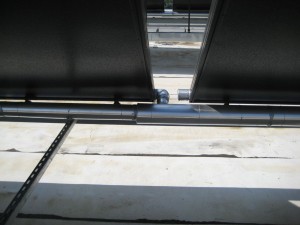More Solar Thermal Lessons from Bethesda
Suppose for some crazy reason we had installed a pressurized glycol solar thermal system at the Warrior Transition Unit in Bethesda instead of a non-pressurized drainback one. Think about what that system is doing right now… 50 collectors just sitting there out in the bright summer sun. The system has been commissioned, meaning it’s operational, BUT there is no hot water load yet. The building is vacant and from the looks of it there won’t be anyone moving in for several more months.
This scenario is an absolute nightmare for a pressurized glycol system. The system is running with no load in the middle of the summer. Power and water have been intermittent. Maybe it will stay on from here on out, maybe not.
A glycol system of this size would require a large heat dump, use night time cooling, or use steam back techniques to dump the excess heat – or all three. All these techniques are problematic. If the power goes off, a heat dump and night time cooling are useless. The steam back method requires tricky sizing of the PR valve and expansion tank, and is not supposed to occur over once/day or things get ugly. I think they get ugly for any steam back process, since the high temp degrades the glycol into acid and fatty deposits.
So, assuming occupancy and loads begin in September, this will be a rough summer for a big glycol system. If it were my system, I would cover all the collectors with tarps and tie them down carefully so they don’t blow off. Then I would go back and remove the tarps after the building was occupied. Then I would cross my fingers.
This doesn’t even begin to address the ongoing maintenance regimen required for a glycol system. The pH of the glycol must be checked annually. The glycol must be recharged every 3 to 5 years which requires a total flushing of the system. During the system flush, one must inspect all check valves, PRVs, air vents, etc. for acid corrosion and glycol breakdown deposits (black goo). This assumes there were no “events” during the 3-5 yr time period. If so, the flush/refill/inspect routine must be done then.
What we did was turn the system OFF, and told the general contractor to turn it back on when the building was occupied, sometime in September.
Would love to hear your feedback!
Dr. Ben

